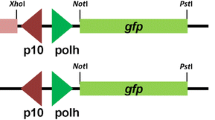Abstract
Objective
To analyze the regulation mechanism of AcMNPV (Autographa californica multicapsid nucleopolyhedrovirus)—mediated expression of BmK IT under IE1, P10 and PH promoters in the larva of Heliothis armigera..
Results
The transcription level of BmK IT gene in midgut and epidermal tissue was analyzed by quantitative PCR. The start time of transcription of recombinant BmK IT gene was early under the regulation of IE promoter, whereas transcription of BmK IT was high under the regulation of P10 promoter in the midgut tissue of infected larvae. TdT-UTP nick-end labeling (TUNEL) assay showed the degree of apoptotic cell death in the midgut tissue of AcMNPV-BmK IT-transfected insect larvae was higher than that in the AcMNPV treatment group at 8 h post-infection. The time–effect relationship between the insect’s humoral immunity and regulation of promoters was confirmed in the phenoloxidase activity assay.
Conclusion
The anti-insect mechanism and regulation of different promoters in AcMNPV-BmK IT at molecular and cellular levels provide an experimental basis for the development of recombinant baculovirus biopesticides.



Similar content being viewed by others
References
Ashour MB, Ragheb DA, El-Sheikh ESA, Gomaa EAA, Kamita SG, Hammock BD (2007) Biosafety of recombinant and wild type nucleopolyhedroviruses as bioinsecticides. Int J Environ Res Public Health 4:111–125
Ayres MD, Howard SC, Kuzio J (1994) The complete DNA sequence of Autographa californica nuclear polyhedrosis virus. Virology 202:586–605
Cestele S, Catterall WA (2000) Molecular mechanisms of neurotoxin action on voltage-gated sodium channels. Biochimie 82:883–892
Dai X, Willis LG, Huijskens I, Palli SR, Theilmann DA (2004) The acidic activation domains of the baculovirus transactivators IE1 and IE0 are functional for transcriptional activation in both insect and mammalian cells. J Gen Virol 85:573–582
DiFalco MR, Bakopanos E, Patricelli M, Chan G, Congote LF (1997) The influence of various insect cell lines, p10 and polyhedron promoters in the production of secreted insulin-like growth factor—interleukin-3 chimeras in the baculovirus expression system. J Biotechnol 56:49–56
Fan XJ (2008) Study on recombinant baculovirus with scorpion insect toxin (BmK IT). Dissertation for Doctor’s Degree of Shanxi University, 74. (Chinese, English abstract)
Fan XJ, Zheng B, Fu YJ, Sun Y, Liang AH (2008) Baculovirus-mediated expression of a Chinese scorpion neurotoxin improves insecticidal efficacy. Chin Sci Bull 53:1855–1860
Fu YJ, Lin TT, Liang AH, Hu FY (2014) Effects of recombinant baculovirus AcMNPV-BmK IT on the formation of early cables and nuclear polymerization of actin in Sf9 cells. Cytotechnology. doi:10.1007/s10616-014-9789-x
Goudet C, Chi CW, Tytgat J (2002) An overview of toxins and genes from the venom of the Asian scorpion Buthus martensii Karsch. Toxicon 40:1239–1258
Hao CJ, Xu CG, Wang W, Chai BF, Liang AH (2005) Expression of an insect excitatory toxin, BmK IT, from the scorpion, Buthus martensii Karsch, and its biological activity. Biotechnol Lett 27:1929–1934
Hayakawa T, Rohrmann GF, Hashimoto Y (2000) Patterns of genome organization and content in lepidopteran baculoviruses. Virology 278:1–12
Inceoglu AB, Kamita SG, Hammock BD (2006) Genetically modified baculoviruses: a historical overview and future outlook. Adv Virus Res 68:323–360
Jehle JA, Blissard GW, Bonning BC, Cory JS, Herniou EA, Rohrmann GF, Theilmann DA, Thiem SM, Vlak JM (2006) On the classification and nomenclature of baculoviruses: a proposal for revision. Arch Virol 151:1257–1266
Jiang HB, Wang Y, Yu XQ, Miehael RK (2003) Prophenoloxidase activating proteinase-2 from haemolymph of Manduca Sexta. J Biol Chem 278:3552–3561
Kamita SG, Kang K, Inceoglu AB, Hammock BD (2005) Genetically modified baculoviruses for pest insect control. In: Gilbert LI, Iatrou K, Gill SS (eds) Comprehensive molecular insect science, vol 6. Elsevier, Oxford, pp 271–322
Keddie BA, Aponte GW, Volkman LE (1989) The pathway of infection of Autographa californica nuclear polyhedrosis virus in an insect host. Science 243:1728–1730
Kost TA, Condreay JP, Jarvis DL (2005) Baculovirus as versatile vectors for protein expression in insect and mammalian cells. Nat Biotechnol 23:567–575
Livak KJ, Schmittgen TD (2001) Analysis of relative gene expression data using real-time quantitative PCR and 2−ΔΔCT method. Methods 25:402–408
Moskowitz H, Hermann R, Jones AD, Hammock BD (1998) A depressant insect-selective toxin analog from the venom of the scorpion Leiurus quinquestriatus hebraeus-purification and structure/function characterization. Biochemistry 254:44–49
Niesters HGM (2001) Quantitation of viral load using real-time amplification techniques. Methods 25:419–429
Shi ZH, Sun JH (2010) Immunocompetence of the red turpentine beetle, Dendroctonus valens LeConte (Coleoptera: Curculionidae, Scolytinae): variation between developmental stages and sexes in populations in China. J Insect Physiol 56:1696–1701
Sorrentino RP, Small CN, Govind S (2002) Quantitative analysis of phenoloxidase activity in insect hemolymph. Biotechniques 32:815–816, 818, 820, 822–823
Taggart DJ, Mitchell JK, Friesen PD (2012) A conserved N-terminal domain mediates required DNA replication activities and phosphorylation of the transcriptional activator IE1 of Autographa californica multicapsid nucleopolyhedrovirus. J Virol 86:6575–6585
Tani H, Limn CK, Yap CC (2003) In vitro and in vivo gene delivery by recombinant baculoviruses. J Virol 77:9799–9808
Acknowledgments
This project was supported by grants from ‘National Natural Science Foundation of China (Nos. 31272100, 31372199 and 31400765)’, ‘Natural Science Foundation of Shanxi Province (No. 2014011038-1)’, and ‘the Program for the Top Young Academic Leaders of Higher Learning Institutions of Shanxi’.
Author information
Authors and Affiliations
Corresponding author
Rights and permissions
About this article
Cite this article
Fu, Y., Li, X., Du, J. et al. Regulation analysis of AcMNPV-mediated expression of a Chinese scorpion neurotoxin under the IE1, P10 and PH promoter in vivo and its use as a potential bio-insecticide. Biotechnol Lett 37, 1929–1936 (2015). https://doi.org/10.1007/s10529-015-1875-4
Received:
Accepted:
Published:
Issue Date:
DOI: https://doi.org/10.1007/s10529-015-1875-4




